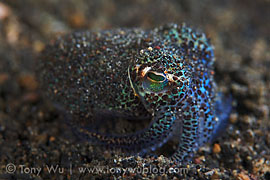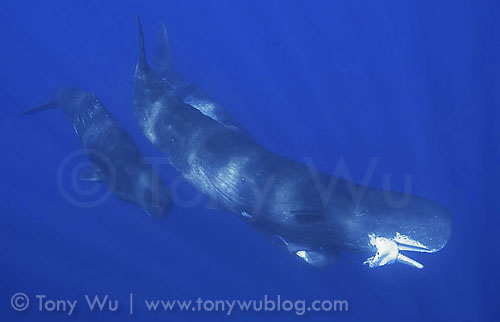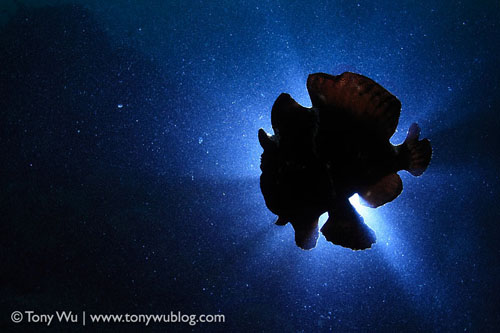It's been a while since I've updated my Upcoming Trips page, largely because I've been travelling so much that it's been difficult for me to hammer out logistical details and communicate with relevant counter-parties.
The year-end quiet period has given me some time to (just barely) catch up, so here's a long overdue update of some of my trips for the near future, set out in chronological order. (I'm doing my best to keep my Upcoming Trips page updated, so bookmark that page if you want to check back later for more trips.)
The Night Safari Lembeh (27 Feb-6 Mar): I'll be heading to Kasawari Lembeh Resort again soon, this time for the primary purpose of checking out the night life. As far as I know, this Night Safari trip is the first-ever organised effort to focus on diving at night in the Lembeh Strait. It'll be fascinating(!) to see what happens late at night, when most (sane) people are asleep.
 In addition to David and Sanah from Scubacam, Aey and Mean from FiNS will be on this trip...and Eric Cheng will be joining as well a few days into the trip. If you're looking for advice about photography or how to prepare your images for print, you'd be hard-pressed to find a better-informed or nicer group of people.
In addition to David and Sanah from Scubacam, Aey and Mean from FiNS will be on this trip...and Eric Cheng will be joining as well a few days into the trip. If you're looking for advice about photography or how to prepare your images for print, you'd be hard-pressed to find a better-informed or nicer group of people.
There are still a few spots left for this trip, so click here to drop David and Sanah an email to sign up! More details here.
Humpback Whale Acoustic Research in Tonga (29 Jul - 7 Aug): In addition to the trips I have scheduled to swim with humpback whales in August this year, I've been working with a marine acoustics researcher friend of mine to try to set up a long-term study of humpback whale acoustics.
 By way of background, my friend Dr. John Potter is a brilliant acoustics researcher who has studied underwater acoustics and marine mammals for over 20 years, pioneering techniques and a new understanding of how marine mammals use sound and how they're affected by man-made sound in the ocean. John is a frequent consultant to sonar companies, navies, governments and NGOs concerned about the acoustic impact on the marine environment. Basically...he knows his stuff. In fact, he was the marine acoustics expert featured in the movie The Cove.
By way of background, my friend Dr. John Potter is a brilliant acoustics researcher who has studied underwater acoustics and marine mammals for over 20 years, pioneering techniques and a new understanding of how marine mammals use sound and how they're affected by man-made sound in the ocean. John is a frequent consultant to sonar companies, navies, governments and NGOs concerned about the acoustic impact on the marine environment. Basically...he knows his stuff. In fact, he was the marine acoustics expert featured in the movie The Cove.
I first met John when he was the head of the Acoustic Research Laboratory at the National University of Singapore, which he started back in 1996. Among the interesting things he shared with me was an amazing video that he and other PhD friends put together showing the source, directionality and strength of humpback singer song in Hawaiian waters...a short sample of which is below:
Though it may not be immediately obvious, this is ground-breaking stuff. By using rebreathers, video cameras, audio recorders and distance measuring devices, John and the other researchers were able to construct this real-time representation of where a humpback's sound comes from, how strong it is (in decibels) at various distances, and also the directionality of sound.
Cool, eh? (Actually, even more cool is the fact that John et al were the ones in the water on rebreathers gathering data first-hand!)
After several years of brainstorming and planning, we're ready to try undertaking a new project in Tonga. We won't be using rebreathers, but we will be pursuing new insights into the characteristics and behaviour of humpback whale singers.
The basic idea is to use a cross-disciplinary approach of combining data in the form of photos, video, high-frequency (i.e., whale-safe) ranging systems, and custom-designed hydrophone arrays to measure singer size, record their songs and other social sounds, and try to discern whether there are any meaningful correlations between songs and whales.
Our intention is to consider basic but as-yet unanswered questions such as whether bigger whales sing louder than smaller ones, whether some whales have deeper voices than others, what role if any age plays in song structure and singing behaviour, etc.
In other words, John and I would like to combine my knowledge of the whales in Tonga with his acoustics expertise to achieve something meaningful.

In order to undertake this project without having to beg for funds, we're asking for help from people who'd like to take part in this research effort by joining us for a few days on the water, aboard John's 52ft (on deck) yacht Jocara, which is now based in Tonga (yes, he relocated his boat to Tonga in 2007 in part as preparation for this), managed and operated by our mutual friend Christy.
We're hoping to kick off this effort with two back-to-back trips in 2010:
Trip 1: 29 Jul - 2 Aug (4 nights aboard Jocara)
Trip 2: 3 Aug - 7 Aug (4 nights aboard Jocara)
To cover operating costs, we're looking for four people on each of the trips, with cost/ person at US$1250. This includes everything while on the boat, as well as discussions that John will lead about marine mammal acoustics, and marine mammal photography advice/ discussions about humpbacks in Tonga from me (excludes accommodation, meals, etc. off the boat, and air travel).
While this isn't going to be as intensive a photography-oriented trip as the others I have planned, we will get into the water at every opportunity, and we will be taking photos and recording video.
If you're interested in learning more about humpback whales and helping out with cutting-edge acoustics study of whale song, please contact me via my contact form.
To be honest, this is a departure from the type of trip I usually do, but it's something that I believe will be worthwhile over the long-run in expanding our knowledge about these graceful marine mammals.
As with the humpback whale calf-count that I started a couple of years ago, John and I will make every effort to share via the internet any insights we gather, and we look forward to feedback and contributions from all interested parties.
Sperm Whales, Ogasawara (early-mid October): Following on the incredible success of last year's inaugural trip to Ogasawara, I'm planning another visit to Ogasawara in October this year.
Among the highlights of last year's trip, we photographed and video-ed a group of female sperm whales eating a giant squid and possibly teaching the calf in the group how to hunt for squid (which means this year...we'll have to photograph a giant squid engaged in a life-or-death struggle with a sperm whale!)

On a separate occasion, I swam down and recovered a 351cm segment of a giant squid feeding arm. We also found leftover deep-water octopus parts, swam with dolphins and encountered Bryde's whales. Come to think of it, we were quite busy!
While in Ogasawara, I also realised that it's possible to ID sperm whales by markings on their lower ventral areas, and I subsequently compiled a summary of nine individual whales that we encountered. I'm hoping to build on this ID catalog over time, working with the local whale watching authorities to see if we can document repeat visits to the area by these enigmatic cetaceans.
The exact trip dates depend on the ferry schedule between Tokyo and Ogasawara. Last year, the ferry schedule was only announced in July, and the trip was from 8 to 19 October (though I had a good idea of the probable schedule a few weeks prior to the official announcement).
Also, the exact cost depends upon the class of berth aboard the ferry, the number of people on the trip, and the number of days we're out on the water...so participation in this trip requires a measure of flexibility. A reasonable estimate is Yen 600,000-700,000/ person for 8-9 days on the water.
Yes, I realise that's not terribly specific...but that's the nature of the situation, and it's totally worth the effort and pain-in-the-rear factor when you're face-to-face with sperm whales. Just ask any of the people who were with me this year!
If you're interested in going to Ogasawara in early- to mid-October to look for sperm whales, please contact me via my contact form.
The Night Safari Ambon (7-16 Nov): Yes, yes...I'm obsessed with night life this year. After helping to plan the Night Safari Lembeh trip, I realised that the conditions in Ambon are ideal for a Night Safari type of excursion as well.
First, Maluku Divers have just recently opened their new resort, which is located right atop the best muck dive sites in Ambon. This means access to dive sites is easy...and night diving is possible/ practical in the area for the first time in many years.
Second, the new resort was designed and built by my good friend Yos, who coincidentally designed and built Kasawari-Lembeh Resort as well. Yos is a diver himself, and he has really good taste, so I have no doubt that the accommodations and facilities at the new resort in Ambon will be as nice and photographer-friendly as at Kasawari-Lembeh Resort.
And finally, the critter life in Ambon harbour is simply amazing! Need I say more?

I'm arranging The Night Safari Ambon in conjunction with Eric Cheng and Wetpixel, so there will no doubt be lots of experienced underwater photographers on the trip with lots of stories and advice to share. If you're interested in joining this adventure, please refer to the trip summary below:
Trip: The Night Safari Ambon
Trip Leaders: Eric Cheng and Tony Wu
Host: Maluku Divers
Dates/ Diving Schedule: Arrive 7 November 2010, depart on 16 November.
The planned diving schedule comprising 21 dives is:
7 November: Arrive/ set up cameras
8 -9 November: Normal day-diving schedule
10 November: Transition schedule: 14:30; 17:30; 20:30
11-13 November: Night schedule: 17:30; 20:30; 23:30
14 November: Transition schedule: 14:30; 17:30; 20:30
15 November: Off-gas/ Optional land tour (separate cost)
16 November: Depart
Diving Style: Ambon has a combination of reef and muck diving. For this trip, we will be concentrating on muck/ critter diving, and we will devote much of the trip to diving in the evening and night. Although the resort is situated at the best critter sites, we will dive from boats. The dive sites are located inside Ambon bay, and most of the time, we will be diving in relatively shallow water.
Because we will be diving a lot at night, you will need to bring adequate lighting. A minimum of two torches (three would be better) plus lots of batteries would be a good idea.
Also, while the muck sites are sheltered and shallow, there can be strong current at times. Our night dives will be concentrated during the period between new moon and first quarter moon, so in theory, the current will not be strong.
However, you never know with Mother Nature, so we'll need to be flexible and adapt to prevailing conditions.
For a better idea of what Ambon is like, see:
http://www.vuvox.com/collage/detail/0b194b887
Also, this is a PDF of an article about Ambon. The text is in Japanese, but the photos will give you more of an idea of what kind of marine life to expect.
http://www.tonywublog.com/wp-content/uploads/2009/10/ambon.pdf
Finally, the dive sites we will be diving are where the newly described Maluku frogfish (Histiophryne psychedelica) has been found. We will, of course, hope to see this elusive fish, but to date, only a handful of these animals have been spotted, so please manage your expectations accordingly.
Accommodation: Twin-share rooms at the newly completed Maluku Divers dive resort, which is located at the prime muck dive sites at Laha. All rooms have hot water and aircon, as well as two editing desks with charging stations for batteries. The resort is equipped with back-up generators, so we'll be insulated from power outages on the island. There is no Nitrox available at this time.
Meals are Indonesian fare, primarily comprising fresh fish and seasonal vegetables. If you have any special dietary requirements, please inform us well in advance so the resort can try to accommodate. Please bear in mind that Ambon is a remote location and some things are not always readily available.
Cost/ Person: US$2,495
Deposit/ Person: US$1,000 to confirm
Balance: Balance of payment due 1 July 2010.
Contact Person for booking: Dan Baldocchi
Getting There: There are regular flights to Ambon from Bali, Manado and Jakarta on Lion Air and Batavia Air. While it is possible to make reservations yourself, it's best to let the resort handle domestic flight reservations, coordinated through Dan Baldocchi. Domestic itineraries and prices generally firm up within three months of the date concerned, so expect that final itineraries will become clear around mid-August.
Power Supply: Power in Indonesia is 230V/ 50Hz. There are charging stations in the cabins and in the dedicated camera room. Plug shape is recessed two-prong, Type F on this page: http://users.telenet.be/worldstandards/electricity.htm
Please note: 110V is not available.